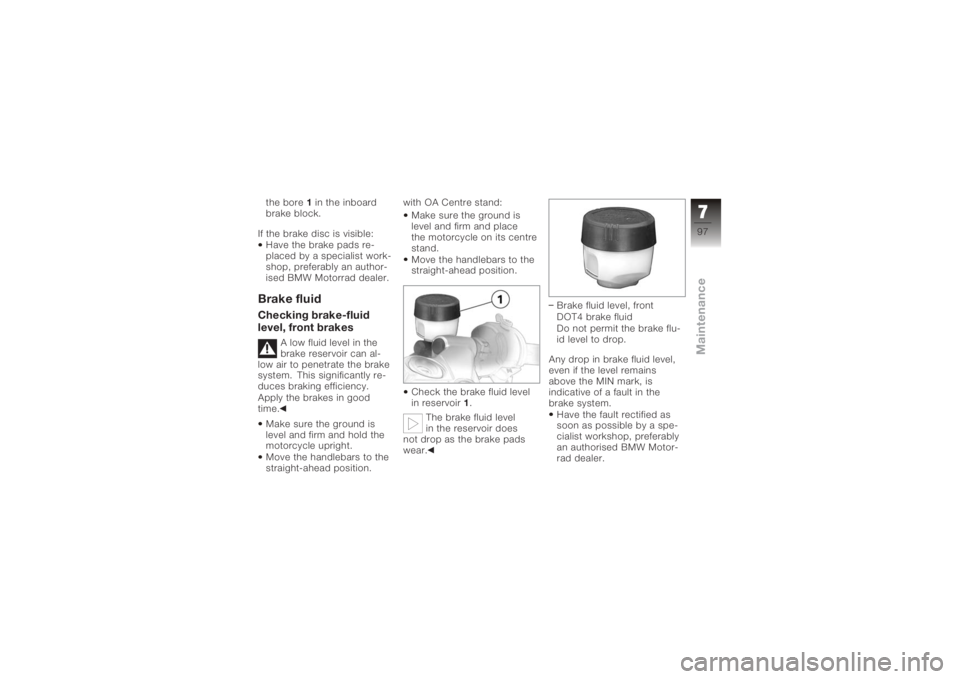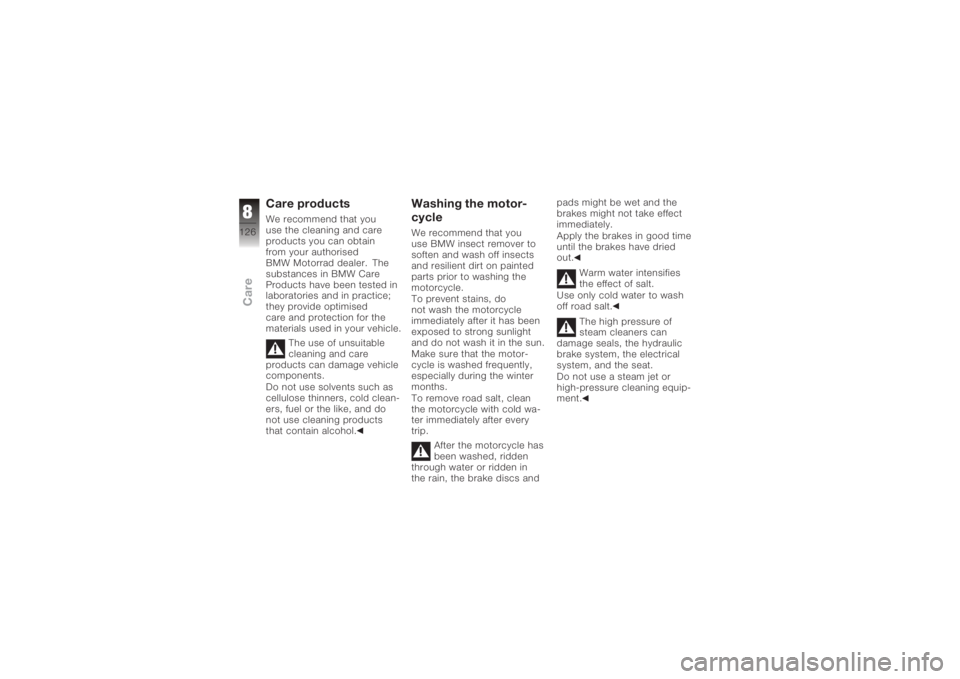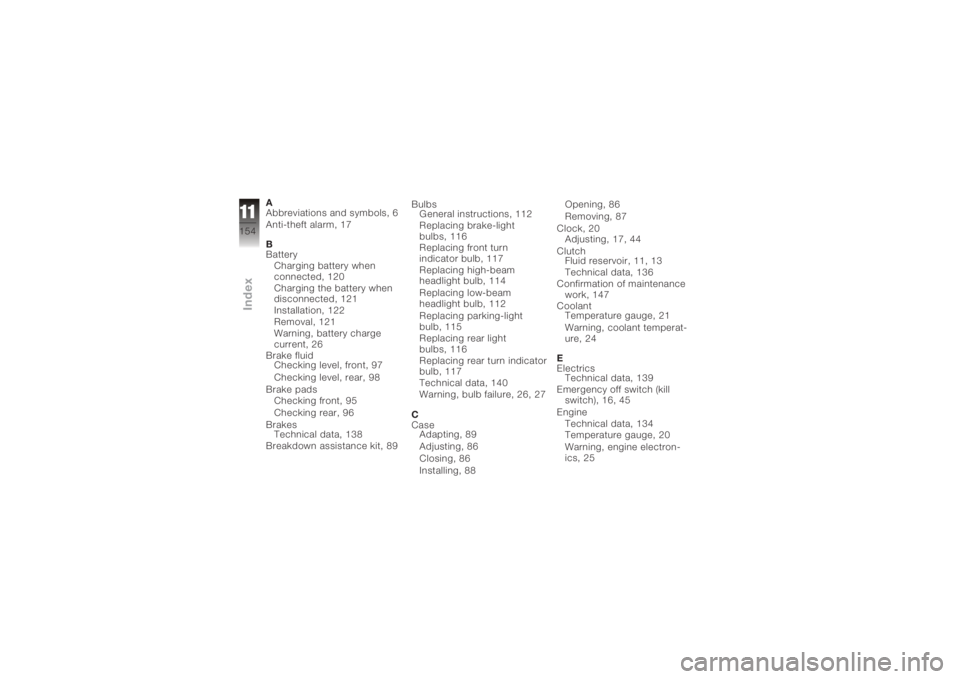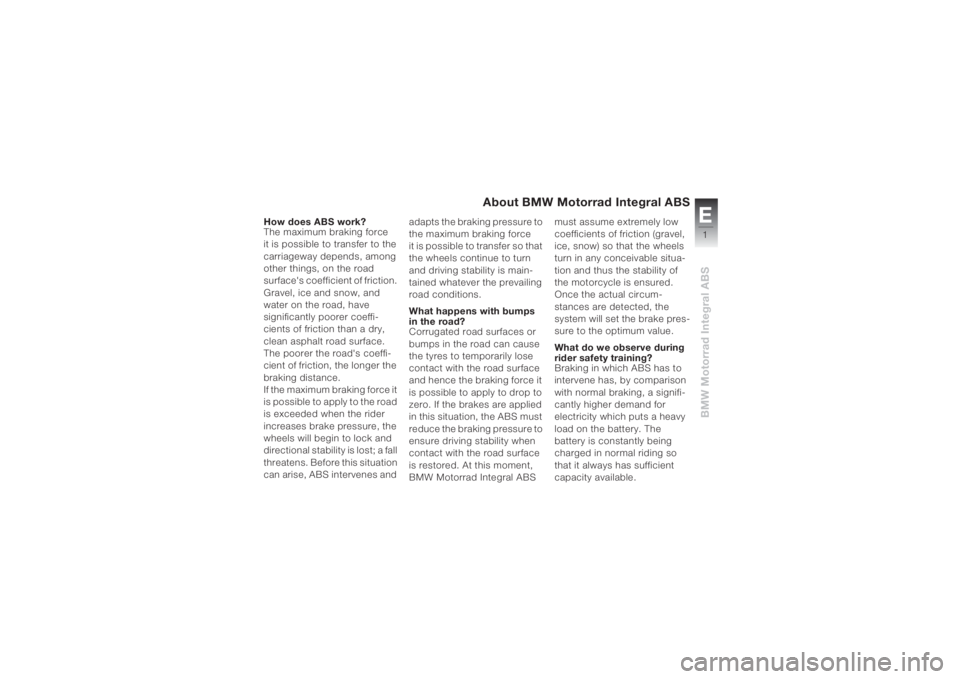Page 99 of 165

the bore 1in the inboard
brake block.
If the brake disc is visible: Have the brake pads re-
placed by a specialist work-
shop, preferably an author-
ised BMW Motorrad dealer.Brake fluidChecking brake-fluid
level, front brakes
A low fluid level in the
brake reservoir can al-
low air to penetrate the brake
system. This significantly re-
duces braking efficiency.
Apply the brakes in good
time.
Make sure the ground is
level and firm and hold the
motorcycle upright.
Move the handlebars to the
straight-ahead position. with OA Centre stand:
Make sure the ground is
level and firm and place
the motorcycle on its centre
stand.
Move the handlebars to the
straight-ahead position.
Check the brake fluid level
in reservoir 1.
The brake fluid level
in the reservoir does
not drop as the brake pads
wear. Brake fluid level, front
DOT4 brake fluid
Do not permit the brake flu-
id level to drop.
Any drop in brake fluid level,
even if the level remains
above the MIN mark, is
indicative of a fault in the
brake system. Have the fault rectified as
soon as possible by a spe-
cialist workshop, preferably
an authorised BMW Motor-
rad dealer.
797zMaintenance
Page 100 of 165
with OE No BMW Motorrad
Integral ABS:Check the brake fluid level
in reservoir 1.
The brake fluid level in
the brake fluid reser-
voir drops as the brake pads
wear. Brake fluid level, front
with OE No BMW Motorrad
Integral ABS:
DOT4 brake fluid
Do not permit the brake flu-
id level to drop below the
MIN mark.
If the brake fluid level drops
below the permitted level: Have the fault rectified as
soon as possible by a spe-
cialist workshop, preferably
an authorised BMW Motor-
rad dealer.
Checking brake-fluid
level, rear brakes
A low fluid level in the
brake reservoir can al-
low air to penetrate the brake
system. This significantly re-
duces braking efficiency.
Apply the brakes in good
time.
Make sure the ground is
level and firm and place the
motorcycle on its stand.
Check the brake fluid level
in reservoir 1.
798zMaintenance
Page 128 of 165

Care productsWe recommend that you
use the cleaning and care
products you can obtain
from your authorised
BMW Motorrad dealer. The
substances in BMW Care
Products have been tested in
laboratories and in practice;
they provide optimised
care and protection for the
materials used in your vehicle.The use of unsuitable
cleaning and care
products can damage vehicle
components.
Do not use solvents such as
cellulose thinners, cold clean-
ers, fuel or the like, and do
not use cleaning products
that contain alcohol.
Washing the motor-
cycleWe recommend that you
use BMW insect remover to
soften and wash off insects
and resilient dirt on painted
parts prior to washing the
motorcycle.
To prevent stains, do
not wash the motorcycle
immediately after it has been
exposed to strong sunlight
and do not wash it in the sun.
Make sure that the motor-
cycle is washed frequently,
especially during the winter
months.
To remove road salt, clean
the motorcycle with cold wa-
ter immediately after every
trip.
After the motorcycle has
been washed, ridden
through water or ridden in
the rain, the brake discs and pads might be wet and the
brakes might not take effect
immediately.
Apply the brakes in good time
until the brakes have dried
out.
Warm water intensifies
the effect of salt.
Use only cold water to wash
off road salt.
The high pressure of
steam cleaners can
damage seals, the hydraulic
brake system, the electrical
system, and the seat.
Do not use a steam jet or
high-pressure cleaning equip-
ment.
8126zCare
Page 133 of 165
Technical data
Troubleshooting chart........ 132
Threaded fasteners . . . ........ 133
Engine ....................... 134
Riding specifications . ........ 136
Clutch ....................... 136
Transmission . . . .............. 136
Final drive . ................... 137
Running gear . . . .............. 137
Brakes ....................... 138
Wheels and tyres ............. 138
Electrics . . ................... 139
Frame ....................... 141
Dimensions .................. 141
Weights . . . ................... 142
9131zTechnical data
Page 140 of 165
BrakesFront brake, typeHydraulically operated twin disc brake with 4-
piston fixed calipers and floating brake discs
Front brake pads, material Sintered metal
Rear brake, type Hydraulically operated disc brake with
2-piston floating caliper and fixed disc
Rear brake pads, material Organic materialWheels and tyresFront wheel, typeCast aluminium, MT H2
Front wheel, rim size 3.50" x 17"
Front wheel, tyre designation 120/70 ZR 17
Rear wheel, type Cast aluminium, MT H2
Rear wheel, rim size 6.00" x 17"
Rear wheel, tyre designation 190/50 ZR17
Tyre pressures
Front wheel, tyre pressure 2.5 bar, When cold
Rear wheel, tyre pressure 2.9 bar, When cold
9138zTechnical data
Page 156 of 165

A
Abbreviations and symbols, 6
Anti-theft alarm, 17
B
BatteryCharging battery when
connected, 120
Charging the battery when
disconnected, 121
Installation, 122
Removal, 121
Warning, battery charge
current, 26
Brake fluid Checking level, front, 97
Checking level, rear, 98
Brake pads Checking front, 95
Checking rear, 96
Brakes Technical data, 138
Breakdown assistance kit, 89 Bulbs
General instructions, 112
Replacing brake-light
bulbs, 116
Replacing front turn
indicator bulb, 117
Replacing high-beam
headlight bulb, 114
Replacing low-beam
headlight bulb, 112
Replacing parking-light
bulb, 115
Replacing rear light
bulbs, 116
Replacing rear turn indicator
bulb, 117
Technical data, 140
Warning, bulb failure, 26, 27
C
Case Adapting, 89
Adjusting, 86
Closing, 86
Installing, 88 Opening, 86
Removing, 87
Clock, 20 Adjusting, 17, 44
Clutch Fluid reservoir, 11, 13
Technical data, 136
Confirmation of maintenance work, 147
Coolant Temperature gauge, 21
Warning, coolant temperat-
ure, 24
E
Electrics Technical data, 139
Emergency off switch (kill switch), 16, 45
Engine Technical data, 134
Temperature gauge, 20
Warning, engine electron-
ics, 25
11154zIndex
Page 158 of 165

LightsSwitching off the parking
lights, 48
Switching on the high-beam
headlight, 47
Switching on the low-beam
headlight, 47
Switching on the parking
lights, 48
Switching on the side
lights, 47
M
Multifunction display, 17, 20
O
On-board computer Ambient temperature, 43
Average consumption, 43
Average speed, 42
Pushbutton, 15
Resetting average con-
sumption, 43
Resetting average
speed, 42 Residual range, 42
Selecting readings, 41
Tripmaster function, 41
P
Power socket, 11, 13
Pre-ride check, 63
R
Rear wheel stand Installing, 111
Refuelling, 76
Reserve Warning, 24
Residual range, 40, 42
Restoring to use, 129
Rev. counter, 17
Running gear Technical data, 137
S
Seat Installation, 51
Lock, 11, 13
Removal, 50
Service, 144 Side stand
Starting the engine, 62
Speedometer, 17
Spring preload, rear Adjusting, 11, 13, 54
Starter, 16
Steering lock, 37
Suspension damping, rear Adjusting, 11, 13, 54
T
Technical data Brakes, 138
Bulbs, 140
Clutch, 136
Electrics, 139
Engine, 134
Engine oil, 135
Final drive, 137
Frame, 141
Fuel, 135
Running gear, 137
Transmission, 136
Wheels and tyres, 138
Telltale lights, 17
11156zIndex
Page 162 of 165

E1BMW Motorrad Integral ABS
About BMW Motorrad Integral ABS
How does ABS work?
The maximum braking force
it is possible to transfer to the
carriageway depends, among
other things, on the road
surface's coefficient of friction.
Gravel, ice and snow, and
water on the road, have
significantly poorer coeffi-
cients of friction than a dry,
clean asphalt road surface.
The poorer the road's coeffi-
cient of friction, the longer the
braking distance.
If the maximum braking force it
is possible to apply to the road
is exceeded when the rider
increases brake pressure, the
wheels will begin to lock and
directional stability is lost; a fall
threatens. Before this situation
can arise, ABS intervenes and adapts the braking pressure to
the maximum braking force
it is possible to transfer so that
the wheels continue to turn
and driving stability is main-
tained whatever the prevailing
road conditions.
What happens with bumps
in the road?
Corrugated road surfaces or
bumps in the road can cause
the tyres to temporarily lose
contact with the road surface
and hence the braking force it
is possible to apply to drop to
zero. If the brakes are applied
in this situation, the ABS must
reduce the braking pressure to
ensure driving stability when
contact with the road surface
is restored. At this moment,
BMW Motorrad Integral ABS must assume extremely low
coefficients of friction (gravel,
ice, snow) so that the wheels
turn in any conceivable situa-
tion and thus the stability of
the motorcycle is ensured.
Once the actual circum-
stances are detected, the
system will set the brake pres-
sure to the optimum value.
What do we observe during
rider safety training?
Braking in which ABS has to
intervene has, by comparison
with normal braking, a signifi-
cantly higher demand for
electricity which puts a heavy
load on the battery. The
battery is constantly being
charged in normal riding so
that it always has sufficient
capacity available. Info_I_ABS_en_xx.fm Seite 1 Dienstag, 19. Juli 2005 2:48 14